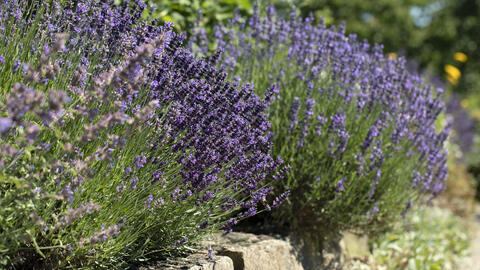Lavender finished flowering? Here’s what you need to do now
Lavender is one of the most popular garden plants. As soon as the semi-shrub has finished flowering, you should reach for the pruning shears - then the chances of a second flowering in late summer will be quite good!

Lavender charms us with its fragrance during the flowering period and is positively swarmed by bees
Almost no other plant brings Mediterranean flair to the garden like Lavender. Most flower shoots have finished flowering by the end of July and start of August. When this happens, you should waste no time and consistently prune back the old blooms every year in the summer.
Lavender has a dense leafy, bushy base from which the almost bare flower shoots emerge in the course of the spring and early summer. The flowers of the plant stand 7.87 to 11.81 inches over the gray-leafed side shoots. When these shoots have finished flowering, you should consistently prune back to the bushy, leafed part of the plant. Most hobby gardeners follow a one-third-two-third rule when pruning Lavender. This stipulates you prune back the plants by a third in the summer and two thirds in the spring. This is a little imprecise, as the flower shoots are often as long as the shrub base is tall. So you it’s better to orientate yourself according to that. The correct time is also important: Don’t wait until all the lavender flowers have finished. The earlier you prune back the Mediterranean semi-shrub, the better it will grow new shoots. There will then often be a second, somewhat weaker flowering in long summers from the end of August or start of September.
If you use normal garden shears to prune back in the summer, take a shoot cluster in the hand and cut it off underneath. You don’t have to cut Lavender too precisely. Just make sure that you do not cut off any lower than the bushy shrub base.
If you have lots of individual Lavender or a Lavender flower bed border in the garden, pruning back with a manual hedge trimmer will be much easier. Use it to shorten all the shoots accordingly and then brush up the cuttings with a leaf rake. You can carefully brush out any pruned shoots that stay hanging on the plants with a leaf brush.
Water your Lavender straight after pruning to ensure that it grows new shoots well and flowers a second time. You should also regularly reach for the watering can in the following weeks if it is dry. It’s not necessary to fertilize Lavender; in fact, it’s counter-productive: If Lavender is given too much nitrogen at the height of summer, it does grow lots of new shoots but will rarely re-flower. There is also a risk that the wood will no longer mature properly in the garden, and the plant is more susceptible to frost damage in the winter. If you still want to fertilize the plants, it’s best to use a liquid, low-nitrogen window box flower fertilizer added directly to the water. The undemanding Lavender doesn’t require any further care after pruning.
If you want to cut off Lavender flowers to dry them, you shouldn’t wait until they have finished flowering for the harvest. The fragrant bouquets have the best aroma later if at least half of the flowers on each inflorescence are opened. The best time to cut is a sunny morning, as soon as the dew has dried - that’s when the flowers have the strongest fragrance.



